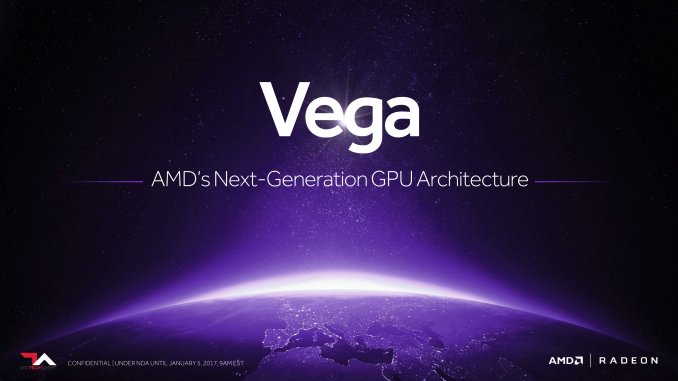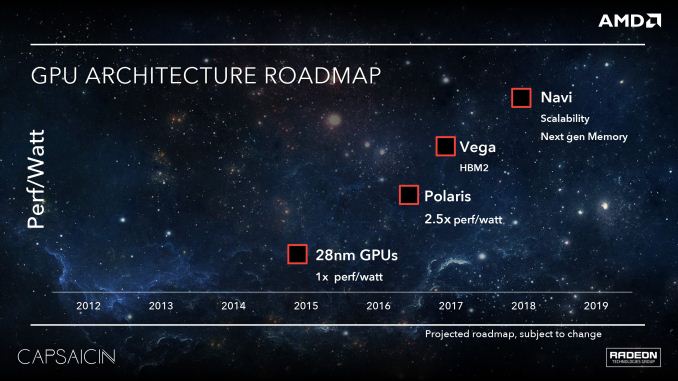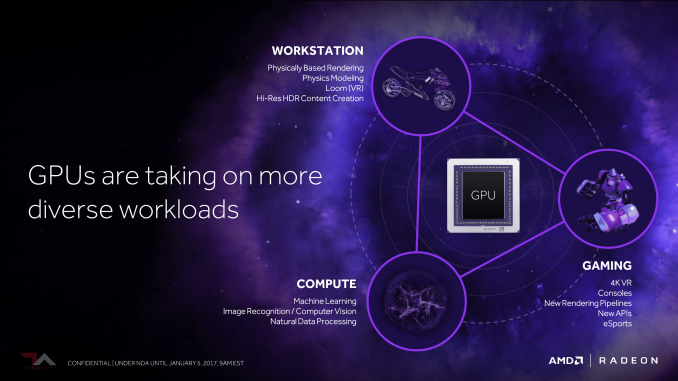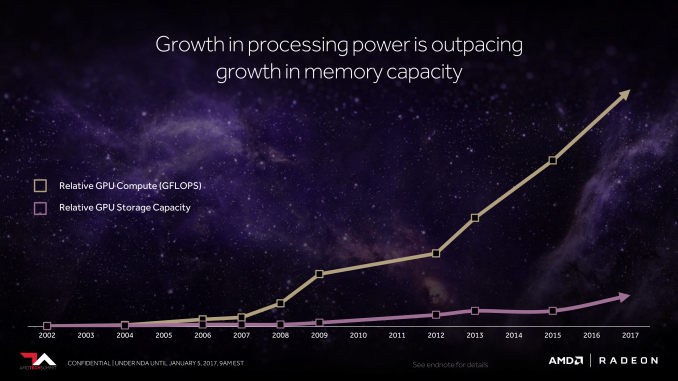The AMD Vega GPU Architecture Teaser: Higher IPC, Tiling, & More, Coming in H1’2017
by Ryan Smith on January 5, 2017 9:00 AM EST
As AMD was in the process of ramping up for the Polaris launch last year, one of the unexpected but much appreciated measures they took was to release a bare-bones GPU architecture roadmap for the next few years. AMD has traditionally held their cards very close to their proverbial chest on what they’re working on next, typically only announcing a new architecture weeks before it’s set to launch in retail products. Polaris itself was a departure from that, as it was announced a good 5 months in advance, but last year’s roadmap was the first honest-to-goodness look we’ve had at AMD’s long-term plans in a long time.
What did that map show us? After 2016’s Polaris would come Vega, and after that would be Navi. As a high-level roadmap it didn’t show us much – in fact other than a timeframe, the only detail attached to Vega was “HBM2” - but it was enough to help understand one of the things AMD would be doing architecturally to set Vega apart from Polaris. As for the timeframe itself, that was ambiguous at best in AMD’s roadmap. But now as we draw closer to the launch of Vega, the picture has become clearer. AMD will be hitting a yearly cadence with Vega. The first chip, which tapped out last year, will be launching in the first half of this year (H1’17).
To that end, with Vega’s launch not too far over the horizon, AMD is ready to start talking about what will be their next GPU architecture. Last year at this time we got our first real glimpse into Polaris and what would become the Radeon RX 480/470/460, and this year AMD is back again with a teaser of things to come with Vega.
Setting The Stage: Expectations Management; Less How & More Why
Before we dive into any architectural details, perhaps it’s best we first set the stage. This goes for both what to expect of today’s announcement, and to better understand what AMD is doing and why.
First and foremost, today’s detail release is a teaser, not a deep dive, or even a preview. AMD is only releasing a few details about Vega, and those are being kept at a high level. In fact it’s fair to say that there’s just enough information to answer little and raise even more questions; just what a proper teaser should be.
Why? Well part of the reason is that we’re still months off from the launch of Vega. I believe it’s fair to say that by announcing a first-half of the year launch date when we’re already in 2017 is a strong indicator that Vega will not launch until later in that window, likely some time in Q2. So we’re still a good three to five months out from the launch of Vega, which means AMD doesn’t want to (or need to) release too many details this far out. Rather they can trickle out chosen details for maximum impact.
At the same time the AMD of 2017 has more they can focus on in the high-performance space than just GPUs. Ryzen launches soon, and they also have other products on the horizon such as the Radeon Instinct accelerators. Polaris received as much detail as it did because it was all AMD really had to talk about, and they needed to recover from a rough 2015 where AMD’s at-the-time power efficiency woes were brought into full focus. But now Vega can share the stage with Ryzen and other products, and that lets AMD be more selective about what they say.
All of which is something I would argue is a good thing. At the end of the day Polaris was an optimized version of the GCN 1.2 (aka GCN 3) architecture for GlobalFoundries’ 14nm FinFET process. The resulting GPUs were solid competitors in the mainstream and value markets, improving on AMD’s power efficiency in a way they badly needed. But they weren’t high-end parts; they didn’t excite like those parts did, and for technology enthusiasts they didn’t significantly change the architecture itself (in fact GCN 4 was ISA compatible with GCN 3, something that doesn’t happen a lot in the GPU space). AMD talked big about Polaris – perhaps too big – and I do think it hurt them in some circles once it became clearer that this was AMD catching up. Which is not to say that AMD’s marketing arm won’t talk big about Vega as well, but they need not ride the technology angle so hard. Vega is a launch that can be more natural and more subdued, especially as at this point we know AMD is aiming big with a much-needed new generation of high-end parts.
In any case, as AMD isn’t riding the technology angle quite as hard in this year’s teaser, they are spending a bit more time explaining the market and some of the logic behind Vega’s design. For its teasing debut, Vega is little less discussion of “how,” and a little more conversation of “why”.
So what is AMD looking to do with Vega? Besides aiming for the high-end of the market, AMD is looking at how the market for GPUs has changed in the last half-decade, and what they need to do to address it. Machine learning is one part of that, being a market that has practically sprung up overnight to become a big source of revenue for GPUs. This is where the previously announced Radeon Instinct will fit in.
But more than that, it’s about fundamental shifts in how workloads are structured. GPU performance growth has far outpaced GPU memory capacity. Scene geometry complexity has continued to grow. Newer rendering methods have significantly changed GPU memory access patterns.
To that end, AMD is looking to address all of these factors with Vega. Which is not to say that this is everything – this is a teaser, after all – but this is where AMD is starting. Where they are going to be with their next generation architecture and how they believe it will address the changes in the market. So without further ado, let’s take a teasing look at what the future has in store for AMD’s GPUs.













155 Comments
View All Comments
jjj - Thursday, January 5, 2017 - link
I get to some 500mm2 too.As for cost, Fiji was on 28nm, much cheaper on an area basis. They will get better yield for packaging but the overall costs will be much higher than with Fiji. They could have a SKU with 25% of the CUs disabled at 499$ and the full Vega 10 at 699 to .. the upper limit depends on where perf lands vs Titan X.
Yojimbo - Friday, January 6, 2017 - link
One must also consider the difference in cost of the process that each chip is made with as well as the price of the larger capacity of HBM2 compared to smaller amount of HBM1. But a smaller interposer will definitely help.It'd better smoke Fiji performance-wise. I think it's a foregone conclusion that it will, though. Judging by their released benchmarks I'm guessing it'll be modestly faster than the 1080, on average, but significantly slower than a forthcoming 1080Ti. So it'll probably be priced around the same $650 as the Fury X.
jjj - Friday, January 6, 2017 - link
You are rushing into judging perf in a big way.AMD is demoing Vega, just showing it up and running ,NOT showing perf. Not quite sure why so many don't get that.
You can bet that it is using early software and that it's clocked at 1-1.2GHz only for now.They are not gonna show their hand ,months before retail availability. They are just showing 4k gaming at 60FPS or better.
You can look at min perf Vega 10 should offer in many ways.
1. It is assumed to have same number of "cores" as the Fury X but almost 50% higher clocks. Then,some 15% architectural and software gains would put it on par with Titan X. So the question is, if they can do better and by how much and at what power.
A note here, given the number of cores , the scaling from 28nm to 14/16nm is very poor. They are clearly sacrificing area for huge gains elsewhere, you wouldn't do it otherwise. 16 and 8 bit is on thing but there must be a lot more.
2. Even the Polaris architecture scaled to 12.5TFLOPS and this memory bandwidth, would match the Titan X. So the question is, how much better can they do.
One could argue that AMD is nuts and Vega is worse than Polaris but that's less than reasonable.
eachus - Saturday, January 14, 2017 - link
The 12.5 TFLOPS is Vega 10 doing 16-bit floating point, not Polaris. And this, in part, explains why Vega 10 doesn't scale well compared to Fury X. There is a new compute engine with lots of new features. I'm hoping that one of them is a fused multiply-add, but we do know that it can do 16-bit floating point twice as fast as single precision (32 bit).So remember that, for now, any comparisons you see with Vega will almost certainly use none of the new features. AMD can and should spend most of their driver effort right now on changes that benefit Polaris. Some support for Vega? Sure, but don't expect support for the new features in drivers until just before (or after) Vega ships.
SunnyNW - Thursday, January 5, 2017 - link
With AMD's countdown on the ve.ga site and their marketing almost everyone thought their would be a live stream incoming, but instead it was a countdown to an NDA lift, like really AMD? I believe AMD made a huge mistake here because there are A LOT of angry people out there whom were waiting with much anticipation. I kinda thought something was odd with the time being 6 a.m. PST and had told my friends as much but still they were convinced too that it was for a live stream.Why has AMD marketing been SO bad for so long, I do think they have gotten a little better in recent history but they are way behind Nvidia for example. It's like AMD has kept the same marketing team for years and years and just does not want to let them go for who knows what reason. In business when you fail for so long who are usually replaced, has AMD just been replacing under-performer after another or just keeping the same people I just don't get it.
And this is coming from someone who is an AMD supporter and would like to see them succeed.
Michael Bay - Thursday, January 5, 2017 - link
Marketing is where careers go to die. If you can even call those things careers.What else do you expect?
alphasquadron - Thursday, January 5, 2017 - link
Marketing for large companies is usually one of the higher paid positions. The ability to persuade a mass of people gets you paid well.eldakka - Friday, January 6, 2017 - link
like a cult leader?The_Assimilator - Friday, January 6, 2017 - link
This is exactly my biggest problem with AMDL: their marketing is, to be frank, absolute bullshit. It's why I don't trust them to deliver on their promises until I see independent reviewers validate them, while if Intel says their next chip is going to have an extra 10% IPC or NVIDIA says their next GPU is going to be 20% faster, I'm inclined to believe those companies.AMD marketing needs to understand the difference between hype and lies, and that consistent lies hurt them far more than they help.
Meteor2 - Friday, January 6, 2017 - link
This. I'm tiring of AMD 'teasing' products.When will it be available? What can it do? How much will it cost? This is what I want to know.